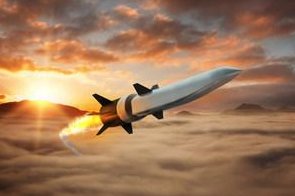This is an artist's rendering of air-breathing hypersonic weapon being developed by Northrop Grumman and Raytheon for the Defense Advanced Research Projects Agency. Photo courtesy of Raytheon/Northrop Grumman
June 18 (UPI) -- Northrop Grumman will develop, produce and integrate scramjet combustors to power Raytheon's air-breathing hypersonic weapons, the two companies said in announcing a teaming agreement.
The two companies in a joint news release Tuesday said they will work together to accelerate the "development and demonstrate readiness to produce the next generation of tactical missile systems."
Scramjet is short for supersonic combustion ramjet. The engines use high vehicle speed to forcibly compress incoming air before combustion to enable sustained flight at hypersonic speeds -- in excess of Mach 5, or 3,800 miles an hour.
These hypersonic speeds reduce flight times and increase weapon survivability, effectiveness and flexibility, according to the companies.
"The Raytheon/Northrop Grumman team is quickly developing air-breathing hypersonic weapons to keep our nation ahead of the threat," said Dr. Thomas Bussing, vice president of Raytheon Advanced Missile Systems. "This agreement combines Raytheon's decades of tactical missile expertise with Northrop Grumman's extensive scramjet engine development experience to produce the best possible weapons."
Northrop Grumman and Raytheon have a $200 million contract for the Hypersonic Air-breathing Weapon Concept, or HAWC, with the Defense Advanced Research Projects Agency and U.S. Air Force.
"This teaming agreement extends our strong partnership with Raytheon on this critical technology capability," said Mike Kahn, vice president and general manager of Northrop Grumman's Defense Systems. "Our deep heritage in propulsion, fuzes and warheads will help accelerate readiness of tomorrow's missiles to meet range, survivability, safety and lethality requirements."
Raytheon is working with Lockheed Martin on a competing hypersonic propulsion system called boost glide. These weapons, including the AGM-183 ARRW -- or Arrow -- are boosted to near-space by ballistic missiles and then glide to their target at high speeds. For the first time, the U.S. Air Force last week successfully tested the hypersonic air-to-ground weapon on a B-52H Stratofortress bomber from Edwards Air Force Base, Calif.
Raytheon and Northrop are ready to make their first flight on the air-breathing system, Bussing said.
"We have a flight test planned for the near future where we will begin flying this particular class of weapon system," he said during a briefing at the Paris Air Show in Le Bourget. The companies have already conducted "significant" ground tests, Bussing said.
All of the scramjet is 3D-printed using advanced materials, said John Wilcox, the company's vice president of advanced programs and technology.
"There gets to be points where you have to weld additive manufactured parts, but right now even the full combustor [is printed]," he said. "We think we're the first to ever 3D print a full combuster for an air-breathing scramjet engine. That's what's going to drive the affordability for air-breathing scramjet missiles."
The weapons are meant to meet the reported development of hypersonic weapons by other nations, specifically Russia and China.















